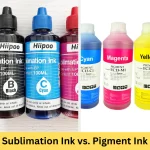Sublimation is a great way to create custom prints on a variety of materials, including shirts, mugs, tumblers, and other sublimation blanks. However, sometimes the prints end up looking dull. So the question arises, how to make sublimation brighter and more vibrant?
A few things affect the vibrancy and quality of your sublimation prints, such as the sublimation printer, ink, sublimation paper, heat press machine’s time, temperature and pressure, and of course the quality of the substrate.
Let’s take a look at some of my secrets of making sublimation prints brighter along with recommended heat press settings – follow this guide to bring your designs to truly come to life.
Having trouble to transfer bright colors on black garments? Choose the right sublimation paper for dark shirts to transfer dyes accurately.
Contents
- Why Sublimation Colors Are Dull?
- How to Make Sublimation Brighter: 10 Tips for Vibrant Prints
- 1. Check the Quality of Your Sublimation Ink
- 2. Use a High-Quality Sublimation Paper
- 3. Adjust Your Printer Settings
- 4. Understanding CMYK and RGB Effects
- 5. Setup of ICC Profiles
- 6. Use the Right Substrate
- 7. Use a Heat Press
- 8. Pre-press Your Substrate
- 9. Apply Proper Heat and Pressure
- 10. Post-press Your Substrate
- Tips on Making Dye-Sublimation Brighter on Mugs
- Conclusion
- Frequently Asked Questions
Why Sublimation Colors Are Dull?
One of the main reasons for sublimation colors to come out dull is the sublimation ink, perhaps you are using a poor quality ink.
Another reason is that the temperature and pressure settings on the heat press machine may not be correct. And, the press time – pressing for too short or too long affects the vibrancy of colors because the dyes do not get processed properly.
Finally, the substrate (the material being printed on) may not be compatible with sublimation printing, or it’s not ready for sublimation.
Since the new era is mostly about customization, almost everybody is getting towards designing their clothes, mugs, and other belongings. But remember, everything is not designed for sublimation – that’s why we end up having poor-quality designs on the items.
How to Make Sublimation Brighter: 10 Tips for Vibrant Prints
It’s true that sublimation can be a complicated process for beginners, but one should not avoid it. Who doesn’t want their personalized items to stand out like a shining star?
Sublimation is the answer to all your printing needs, but these prints do not end up as bright as we expect them. However, if your new sublimation prints look faded or dull, follow these tips to make them brighter;
1. Check the Quality of Your Sublimation Ink

If you are not sure, ask the supplier which dye is compatible with your sublimation printer, or do some research on the internet.
Once you have determined the quality of your ink, you can move on to the next step.
2. Use a High-Quality Sublimation Paper

If the prints are bright and vibrant on the transfer paper, chances are they will produce better results on the substrate too.
3. Adjust Your Printer Settings
The next thing you need to do is adjust your printer settings. You might need to increase the DPI settings. DPI (dots per inch) refers to the resolution of a printer. The higher the DPI, the more dots per inch the printer can print. This results in a sharper image.
A high DPI is far better for sublimation because it will provide the design with sharp edges and clear details.
This will ensure that the ink is being deposited onto the substrate correctly and will help to prevent any fading or color bleeding.
4. Understanding CMYK and RGB Effects
Sublimation printers use CMYK ink, which stands for cyan, magenta, yellow, and key (black). RGB ink, on the other hand, stands for red, green, and blue.
When you create a design for sublimation printing for any product, whether it is a shirt or a mug, etc. it is necessary to use CMYK colors. If you use RGB colors, the colors may not look as vibrant as they do on a computer screen.
5. Setup of ICC Profiles
ICC profiles are used to ensure that colors are accurately reproduced when printing. It can vary from substrate to substrate and wrong settings will definitely change the final results.
When sublimating a design, use the correct ICC profile for the substrate being printed on. This will help to ensure that the colors look as intended.
6. Use the Right Substrate

For example, if you are trying to sublimate onto a dark-colored garment, you’ll likely need to use a transfer paper specifically designed for dark garments.
In addition, sublimation on 100% polyester shirts comes out much brighter than on cotton shirts. Similarly, mugs with proper micro-thin polyester coating are especially created for sublimation, and prints on those mugs come more vibrant than normal white mugs.
7. Use a Heat Press
If you are not using a heat press, now is the time to invest in one. A heat press machine will help to ensure that your design is being transferred correctly and will also prevent any color bleeding or fading.
We do not recommend using an iron or any other alternative to the heat press, results will not look vibrant.
Also, use the correct settings of temperature and pressure on the heat press machine. And, the press time – pressing for too short or too long affects the vibrancy of colors because the dyes do not get processed properly.
8. Pre-press Your Substrate
Another important step in the sublimation process is pre-pressing your substrate. This simply means that you’ll need to heat up your substrate before you begin the transfer process.
This will help open up the substrate’s pores (most likely fabric) and allow the ink to be absorbed more easily.
9. Apply Proper Heat and Pressure

This is one of the most important steps in the sublimation process, and it’s essential to get it right.
You’ll need to set the temperature and pressure according to the manufacturer’s instructions. This will help the colors “pop” more.
10. Post-press Your Substrate
After you have transferred your design, it’s important to post-press your substrate. This step will help to seal the ink and prevent any color bleeding or fading.
Note: not every substrate will require the post-pressing, read the instruction before!
Tips on Making Dye-Sublimation Brighter on Mugs
We often get faded prints on mugs and they look very awful! Follow these tips if you want to make your sublimation prints brighter on ceramic mugs;
1. The first thing you should do is invest in a good quality sublimation mug.
2. The next thing you need to do is to adjust your printer settings. Increase the print quality or DPI settings.
3. Choose the right type of sublimation paper to transfer the design to the mug. If you are trying to sublimate onto a dark-colored mug, you’ll need to use a transfer paper specifically designed for dark colors.
4. Use a heat press machine that is especially designed for mugs, it will ensure that your design is being transferred correctly and will also prevent any color bleeding or fading.
5. Always pre-press with a heated heat press before starting sublimation, this will open up the pores of the ceramic layer and allow the ink to be absorbed easily.
Video Tutorial on Making Mug Sublimation BrighterWhile sublimation printing, there are a few things you want to avoid in order to maintain vibrancy in your colors.
- Do not use too much heat. When the temperature is too high, it can cause the colors to become muted and less vibrant.
- Do not use an old transfer paper. The older the paper, the more likely it is to absorb the ink, making the colors less vibrant.
- Avoid using lower-quality sublimation ink. Lower quality links often have fewer pigment particles, which can result in dull and boring colors.
Conclusion
We shared these tips after doing multiple sublimation projects including t-shirts, tote bags, caps, mugs, metal tumblers, and glass. By following the proper steps and avoiding some common mistakes, you can ensure that your sublimation colors are bright and vibrant.
By using high-quality sublimation inks, transfer papers, substrates, and applying the correct amount of heat and pressure for the recommended time, you can create beautiful prints that will last for years.
Also, learn how to do sublimation on vinyl.
Frequently Asked Questions
Can I use any type of paper for sublimation?
No, you cannot use any type of paper for sublimation. You must use a transfer paper that is specifically designed for sublimation printing. This type of paper is coated with a polymer that helps to prevent ink absorption and ensure bright and vibrant colors.
What is the best substrate for sublimation?
The best substrate for sublimation is a white or light-colored garment. Darker garments can cause the colors to appear muted and less vibrant.
Why are my sublimation colors dull?
There are a few reasons why your sublimation colors might be dull:
- You are using too much heat. When the temperature is too high, it can cause the colors to become muted and less vibrant.
- You are using an old transfer paper. The older the paper, the more likely it is to absorb the ink, making the colors less vibrant.
- You are using lower-quality sublimation ink. Lower quality links often have fewer pigment particles, which can result in dull and boring colors.
- You are printing on a dark-colored substrate such as a black garment. This can cause the colors to appear muted and less vibrant.
- You have not used enough pressure when pressing. This can cause the ink to be absorbed into the substrate, making the colors less vibrant.
- 5 Best 13×19 Sublimation Printer for Wide Format Substrates - December 27, 2023
- Best 11×17 Sublimation Printer to Print Tabloid Size Paper - December 26, 2023
- Epson ET-8550 vs ET-15000: Best Wide-Format EcoTank Printer - December 25, 2023







